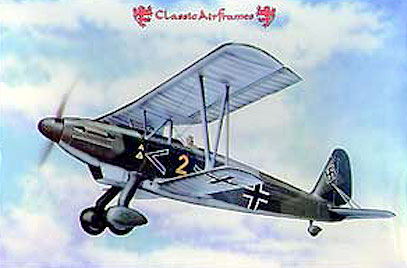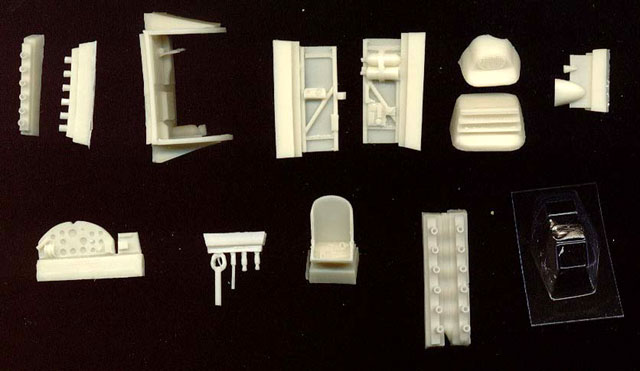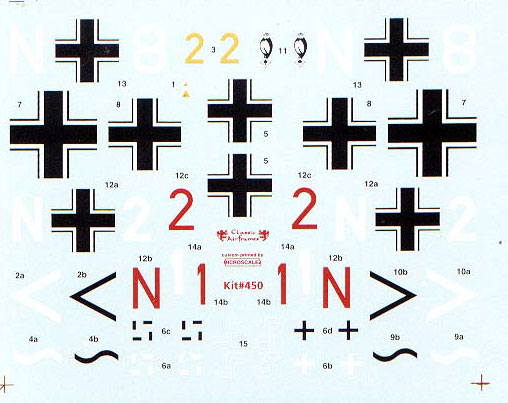|
Arado Ar 68

Classic Airframes

Classic
Airframes' 1/48 scale Arado Ar 68 is available online from Squadron.com
S
u m m a r y
|
| Catalogue Number
: |
450 |
| Scale: |
1/48 |
| Price: |
USD$34.95 RRP (USD $29.96 from
Squadron.com) |
| Contents and Media: |
Gray styrene; resin detail parts; decal sheet with four marking options. |
| Review Type: |
FirstLook |
| Advantages: |
Simple parts breakdown; well
detailed (especially the cockpit); minimal rigging; parts supplied for E
or F variants; . |
| Disadvantages: |
Some modeling skills required |
| Recommendation: |
Recommended for experienced
modellers. |
Reviewed by Lynn
Ritger
The second aircraft designed by the talented
Dipl.Ing. Walter Blume, the Arado Ar 68 entered service as the successor to the
Heinkel He 51. There was initially some reluctance on the part of the
active-duty pilots as to the superiority of the Arado over the older Heinkel
design, but a spirited display by Ernst Udet soon put paid to those misgivings.
From early 1936 onwards, the Arado became an
increasingly common sight on Luftwaffe airfields, and featured in the succession
of daring diplomatic bluffs perpetrated by Hitler on the nations of Europe
througout the latter part of the 30s. From the reoccupation of the Rhineland on
7 March 1936 (with III./JG134 "Horst Wessel"), on to Anschluss of Austria and
the bloodless selling-out of Czechoslovakia in 1938, the Ar 68 formed an
integral part of the Luftwaffe until mass-production of the vastly superior Bf
109 supplanted the biplane in operational fighting units.
As an indication of just how rapid that changeover took place, the Luftwaffe
still had 640 Ar 68s on operational charge on 26 September 1938, versus 171 Bf
109s. One year later, the figure had withered to a mere 28 Arados compared to
747 Bf 109s. The remaining Arados were sent to various Jagdfliegerschule
(fighter schools) throughout Germany, Austria, and Czechoslovakia.
Arado Ar 68 Colors and Markings
For those interested in what the various
colors and markings mean on these prewar Arados and Heinkels, the following
explanation may prove to be of some interest:
--Cowling and decking colors denoted an "Traditional" color assigned to the
unit, with the following examples being most familiar:
The following markings denoted an aircraft's
assignment to a given Staffel:
1. Staffel = solid
cowl color, no markings aside from aircraft number
2. Staffel = single
white stripe around cowling and aft fuselage, often bordered by "Traditional
Color" if applied
3. Staffel = a
single white dot applied to the forward and upper cowling, both sides of the aft
fuselage, and beneath the aircraft.
There are examples of Ar 68Fs in the markings
of JG131, 134, 135, and 234 in the aforementioned Jagdwaffe book all sporting
"Traditional" colors; there are also "clean" versions showing only an aircraft
number or Stab markings, as well as two Ar 68Es in wargames markings with large
red circles painted over the fuselage and wing Balkankreuze.
Luftwaffe '36...
While there has been a seemingly never-ending
surge of interest in "Luftwaffe 46" subjects, I've found myself increasingly
drawn to the opposite end of that spectrum; "Luftwaffe 36", if you will.
The Ar 68 has appeared in 1/48 just once before to my knowledge, as the subject
of a very well-done Karo-As vacuform which I'm fortunate to have. As the last
biplane fighter to enter Luftwaffe service, it certainly holds a historic place,
and now Jules Bringuier has seen fit to bring us a gorgeous kit which allows one
to model either the Jumo 210-powered Ar 68E, or the more common BMW VI-powered Ar 68F.
In going through various books I have on the Luftwaffe, it's apparent that the
early years have not been very well served until recently. Thankfully, Classic
Colours has come to the rescue with their Jagdwaffe series, and the very first
book in this group should be considered an indispensable resource to anyone
wishing to model the He 51 or Ar 68 in Luftwaffe service. It is from this series
of books, in fact, that the markings for the kits are drawn; kit 453 features "weiße
7" of 3./JG135 at Bad Aibling and "weiße 3" of 3./JG131 in East Prussia, both
based on photos in Section 1, Vol. 1, and there is also one Spanish Civil War
variant taken from Section 1, Vol. 2. Kit 450 features the Arado in decidedly
less colorful plumage, including two nightfighters in overall black and a single
nightfighter in 70/71/65, all from 10.(N)/JG53 early in the war, and an option
for a III./JG132 machine at Jüterbog-Damm in the fall of 1938.
Classic
Airframes' 1/48 Ar 68
|
Classic Airframes' new 1/48 scale Arado Ar 68 kit is well thought-out, with a
minimum of parts. The resin interior is particularly well done.

Of special note is the fact that this aircraft
requires a grand total of three (3) flying wires per side, thus making this an
ideal candidate for those who are traditionally afraid of biplane models because
of the profusion of rigging.
It is possible to build an AradoAr 68E or F from this kit, with the appropriate
cowling parts for both versions being supplied, including the enormous exhaust
manifolds for the nightfighting F models. The instructions call for separating
the individual exhaust tubes for the F model, but a quick dry-fit shows these to
fit right into the holes on the kit as they sit on the casting block- a bit of
reaming on the backside of the cowling apertures may pay dividends when
inserting these.
Click the
thumbnails below to view larger images:
John Valo has already
completed a gorgeous wartime version of the Arado featured elsewhere on
Hyperscale, and as I have two, I am building both concurrently as prewar
Luftwaffe versions (both an E and an F) and will submit a feature to Brett with
photos of the models upon completion.

To sum up, this kit further enhances Classic Airframes' reputation for bringing
us the best in aeronautical esoterica. It is an historic and attractive aircraft
with plenty of visual appeal, and once again we have Jules to thank for making
such choices available to us.
Recommended.
Thanks to Classic Airframes for the review
sample
Review Text and Images Copyright © 2001 by
Lynn Ritger
Page Created 16 September, 2002
Last updated 22 July, 2003
Back to HyperScale
Main Page
Back to Reviews
Page
|
Home | What's
New | Features
| Gallery |
Reviews | Reference
| Forum
| Search